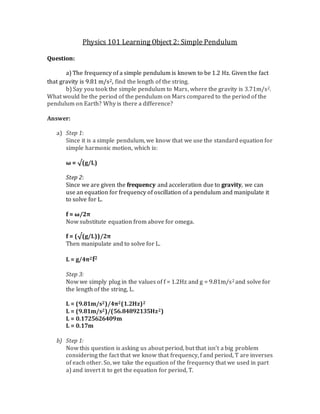Physics 101 Learning Object 2
•Download as DOCX, PDF•
0 likes•131 views
The document solves two problems regarding a simple pendulum: 1) Given the frequency and gravity on Earth, it calculates the length of the pendulum string as 0.17m. 2) It then calculates the periods of the pendulum on Earth (0.83s) and Mars (1.34s), explaining that the period is longer on Mars due to its lower gravity of 3.71m/s2 compared to Earth's 9.81m/s2.
Report
Share
Report
Share

Recommended
More Related Content
What's hot
What's hot (20)
Serway, raymond a physics for scientists and engineers (6e) solutions

Serway, raymond a physics for scientists and engineers (6e) solutions
A Route to Chaos for the Physical Double Pendulum by 

A Route to Chaos for the Physical Double Pendulum by
Similar to Physics 101 Learning Object 2
Similar to Physics 101 Learning Object 2 (20)
Synthesis Problem of Transverse Speed and Archimedes' Principle

Synthesis Problem of Transverse Speed and Archimedes' Principle
Recently uploaded
https://app.box.com/s/tkvuef7ygq0mecwlj72eucr4g9d3ljcs50 ĐỀ LUYỆN THI IOE LỚP 9 - NĂM HỌC 2022-2023 (CÓ LINK HÌNH, FILE AUDIO VÀ ĐÁ...

50 ĐỀ LUYỆN THI IOE LỚP 9 - NĂM HỌC 2022-2023 (CÓ LINK HÌNH, FILE AUDIO VÀ ĐÁ...Nguyen Thanh Tu Collection
Recently uploaded (20)
Home assignment II on Spectroscopy 2024 Answers.pdf

Home assignment II on Spectroscopy 2024 Answers.pdf
50 ĐỀ LUYỆN THI IOE LỚP 9 - NĂM HỌC 2022-2023 (CÓ LINK HÌNH, FILE AUDIO VÀ ĐÁ...

50 ĐỀ LUYỆN THI IOE LỚP 9 - NĂM HỌC 2022-2023 (CÓ LINK HÌNH, FILE AUDIO VÀ ĐÁ...
Overview on Edible Vaccine: Pros & Cons with Mechanism

Overview on Edible Vaccine: Pros & Cons with Mechanism
Unit 8 - Information and Communication Technology (Paper I).pdf

Unit 8 - Information and Communication Technology (Paper I).pdf
Instructions for Submissions thorugh G- Classroom.pptx

Instructions for Submissions thorugh G- Classroom.pptx
plant breeding methods in asexually or clonally propagated crops

plant breeding methods in asexually or clonally propagated crops
How libraries can support authors with open access requirements for UKRI fund...

How libraries can support authors with open access requirements for UKRI fund...
Sectors of the Indian Economy - Class 10 Study Notes pdf

Sectors of the Indian Economy - Class 10 Study Notes pdf
Students, digital devices and success - Andreas Schleicher - 27 May 2024..pptx

Students, digital devices and success - Andreas Schleicher - 27 May 2024..pptx
1.4 modern child centered education - mahatma gandhi-2.pptx

1.4 modern child centered education - mahatma gandhi-2.pptx
Physics 101 Learning Object 2
- 1. Physics 101 Learning Object 2: Simple Pendulum Question: a) The frequency of a simple pendulum is known to be 1.2 Hz. Given the fact that gravity is 9.81 m/s2, find the length of the string. b) Say you took the simple pendulum to Mars, where the gravity is 3.71m/s2. What would be the period of the pendulum on Mars compared to the period of the pendulum on Earth? Why is there a difference? Answer: a) Step 1: Since it is a simple pendulum, we know that we use the standard equation for simple harmonic motion, which is: ω = √(g/L) Step 2: Since we are given the frequency and acceleration due to gravity, we can use an equation for frequency of oscillation of a pendulum and manipulate it to solve for L. f = ω/2π Now substitute equation from above for omega. f = (√(g/L))/2π Then manipulate and to solve for L. L = g/4π2f2 Step 3: Now we simply plug in the values of f = 1.2Hz and g = 9.81m/s2 and solve for the length of the string, L. L = (9.81m/s2)/4π2(1.2Hz)2 L = (9.81m/s2)/(56.84892135Hz2) L = 0.1725626409m L = 0.17m b) Step 1: Now this question is asking us about period, but that isn’t a big problem considering the fact that we know that frequency, f and period, T are inverses of each other. So, we take the equation of the frequency that we used in part a) and invert it to get the equation for period, T.
- 2. f = 1/T T = 1/f Now substitute the equation for f that was used in part a) into the equation. T = 1/((√(g/L))/2π) Now just rearrange, so it doesn’t look so complicated and messy. T = 2π(√(L/g) Step 2: Now, to find the period of the pendulum on Earth, we simply plug in the length, L, that we found in part a) which was 0.17m and the acceleration due to gravity on Earth, gEarth, which is 9.81m/s2. TEarth = 2π(√(L/gEarth) TEarth = 2π(√((0.17m)/(9.81m/s2))) TEarth = 2π(0.1316406315s) TEarth = 0.8271224817s TEarth = 0.83s Step 3: Now that you’ve found the period of the pendulum on Earth, you need to find the period of the pendulum on Mars. You use the exact same equation as above and plug in the value for length, L, from part a) which was 0.17m and the acceleration due to gravity on Mars, gMars, which is 3.71m/s2. TMars = 2π(√(L/gMars) TMars = 2π(√((0.17m)/(3.71m/s2))) TMars = 2π(0.2140609783s) TMars = 1.344984794s TMars = 1.34s Step 4: Now just answer the question in words. The period of the pendulum on Mars is 1.34s compared to the period of the pendulum on Earth, which is 0.83s. The reason for the pendulum having a longer period on Mars compared to Earth is because the acceleration due to gravity on Earth (9.81m/s2) is faster than that on Mars (3.71m/s2).